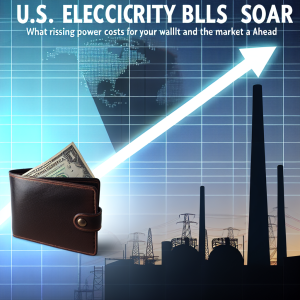Electricity Prices Surge Amid Structural Shifts: What Investors and Advisors Must Know Now
U.S. households are facing a stark reality: electricity prices are climbing at nearly twice the pace of overall inflation. According to the Consumer Price Index for May 2025, electricity costs rose 4.5% year-over-year, while the broader inflation rate for goods and services moved more modestly. The U.S. Energy Information Administration (EIA) projects this trend will continue through 2026, signaling a structural shift in energy economics that demands attention from investors and financial advisors alike.
Why Are Electricity Prices Rising So Rapidly?
At the heart of this surge is a classic economic imbalance—supply is struggling to keep pace with demand. David Hill, EVP of Energy at the Bipartisan Policy Center, underscores that the U.S. is witnessing growing electricity demand combined with the retirement of older power plants faster than new generation capacity is being added. This mismatch is fueling price pressures.
But this isn’t just about supply constraints. Demand patterns are evolving dramatically. Electrification is accelerating across the economy, driven by electric vehicles, smart-home technologies, and particularly the explosive growth of data centers. Data centers alone have tripled their electricity consumption over the past decade and are projected to consume up to 12% of total U.S. electricity by 2028, according to the Department of Energy. This surge is largely fueled by artificial intelligence and cloud computing demands—sectors that are becoming foundational to the digital economy.
Regional Price Variations: A Critical Consideration
Electricity pricing is highly regional, unlike globally traded commodities such as oil. The average U.S. household paid about 17 cents per kilowatt-hour (kWh) in March 2025, but this ranged dramatically—from 11 cents in North Dakota to a staggering 41 cents in Hawaii. The Pacific, Middle Atlantic, and New England regions, where prices are already high, are expected to see increases outpacing the national average.
For investors, this regional disparity suggests that energy infrastructure investments, utility stocks, or real estate exposure in high-cost areas may be more vulnerable to rising energy expenses, potentially impacting disposable incomes and local economies differently.
Infrastructure Challenges Compound the Problem
The U.S. electric grid’s aging infrastructure is another critical bottleneck. Transmission line expansion is lagging far behind federal targets, and transformer shortages are causing multi-year delays in essential upgrades. Michael Cembalest of J.P. Morgan highlights that half of U.S. transformers are nearing the end of their useful life, and replacement costs have soared due to inflation.
This infrastructure deficit not only drives up costs but also raises concerns about grid reliability and resilience—factors that investors should weigh when assessing utility companies or infrastructure funds.
What Should Investors and Advisors Do Differently Now?
-
Prioritize Energy Transition and Infrastructure Plays: With the grid under strain and demand surging, companies involved in modernizing transmission and distribution infrastructure represent compelling investment opportunities. Look for firms specializing in advanced grid technologies, smart meters, and transformer manufacturing.
-
Consider Regional Dynamics in Portfolio Allocation: Given the uneven price hikes, regional utility stocks or real estate investments should be evaluated with local electricity cost trends in mind. High-cost regions may face greater economic headwinds.
-
Monitor the Impact of Data Center Expansion: The rapid growth of data centers is a double-edged sword—fueling demand but also creating niche investment avenues such as specialized REITs (real estate investment trusts) focused on data center properties and tech infrastructure.
- Advise Clients on Energy Efficiency and Electrification Costs: For financial advisors, incorporating energy cost trends into client cash flow projections is increasingly crucial, especially for those in high-price regions or with significant electric vehicle adoption.
Looking Ahead: What’s Next?
The International Energy Agency warns that by 2030, electricity consumption for data processing will exceed that for manufacturing all traditional energy-intensive goods combined. This signals a profound transformation in energy usage patterns, with significant implications for grid management, energy policy, and investment strategies.
Moreover, the slow pace of new power plant development—exacerbated by inflationary pressures on labor and equipment—means supply-side constraints will persist. Investors should watch for policy developments aimed at accelerating clean energy infrastructure and grid modernization, as these will be key drivers of market performance.
Unique Insight: The Crypto Factor
An often-overlooked contributor to rising electricity demand is cryptocurrency mining, which remains highly energy-intensive. While regulatory scrutiny is increasing, mining operations continue expanding in regions with cheaper electricity, adding localized stress to grids and influencing regional price dynamics.
Final Takeaway
Electricity price inflation is not a transient blip but a structural shift driven by demand growth, infrastructure challenges, and evolving technology needs. For investors and advisors, this means recalibrating strategies to incorporate regional electricity cost risks, targeting infrastructure modernization opportunities, and preparing clients for higher energy expenses. Staying ahead in this complex landscape requires a nuanced understanding of both the macro trends and local market realities shaping the future of U.S. electricity.
Sources:
- U.S. Energy Information Administration (EIA)
- Bipartisan Policy Center (BPC)
- J.P. Morgan Asset & Wealth Management
- U.S. Department of Energy
- International Energy Agency (IEA)
By embracing these insights, Extreme Investor Network readers can position themselves to capitalize on the evolving energy landscape and protect their portfolios from the hidden risks of rising electricity costs.
Source: Why electricity prices are surging for U.S. households

